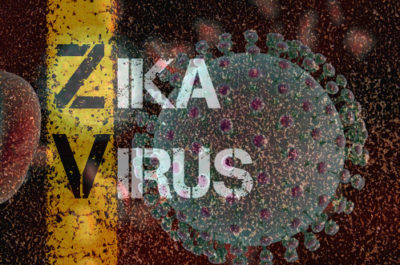 “The Brain defects caused by Zika virus ‘could set evolution back 2 million years’ scientists claim” was the leading story in the UK’s Daily Mirror in February. Since then, the global spread of the Zika virus, previously known as a rare virus, continues as a leading headline story – for good reasons. As CNN reports, “This is the first time a mosquito has been found to cause congenital birth defects.”
“The Brain defects caused by Zika virus ‘could set evolution back 2 million years’ scientists claim” was the leading story in the UK’s Daily Mirror in February. Since then, the global spread of the Zika virus, previously known as a rare virus, continues as a leading headline story – for good reasons. As CNN reports, “This is the first time a mosquito has been found to cause congenital birth defects.”
The New England Journal of Medicine published the article entitled “Zika virus and Birth Defects — Reviewing the Evidence for Causality” on April 13, written by a team headed by Sonja Rasmussen at the U.S. Centers for Disease Control and Prevention (CDC). According to Rasmussen, “sufficient evidence has accumulated to infer a causal relationship between prenatal Zika virus infection and microcephaly and other severe brain anomalies.” Since Zika infections are associated with congenital defects, the Zika virus species is set to test the holy grail of evolution – natural selection.
The Zika virus is a member of the virus family Flaviviridae and the genus Flavivirus. Zika virus is primarily spread by daytime-active Aedes mosquitoes, such as A. aegypti and A. albopictus. Named after the Zika Forest of Uganda from which it was first isolated in 1947, the Zika virus is related to dengue fever, yellow fever, Japanese encephalitis, and West Nile viruses.
Zika Virus Pandemic
Zika virus infections typically produce little-to-no symptoms, similar to dengue fever. Since the 1950s, Zika was considered a relatively benign healthcare issue confined within a narrow Africa-to-Asia equatorial belt.
Within just the past four years, however, Zika started spreading eastward across the Pacific Ocean in 2013 to French Polynesia, New Caledonia, the Cook Islands, and Easter Island. In 2015, the virus expanded into Mexico, Central America, the Caribbean, and South America, where the Zika outbreak has reached pandemic levels. Unfortunately, Zika-associated infection cannot be prevented or treated by any known vaccine or antimicrobial agent.
In response to the pandemic crisis, the CDC January issued enhanced precautions for pregnant women, including a caution against traveling to Zika-infected areas. Colombia, the Dominican Republic, Ecuador, El Salvador, and Jamaica have since taken unprecedented steps to advise women to postpone pregnancy until more is known about the risks associated with exposure to the Zika virus.
BBC News news reporter Wyre Davies, in a May 2 article titled “Zika virus: Risk higher than first thought, say doctors,” reported –
“Zika could be behind more damaging neurological conditions, affecting the babies of up to a fifth of infected pregnant women.”
While a prenatal Zika infection has a known association with severe congenital brain abnormalities, the full extent of the damage in the general population may now include the insidious development of other disorders, including the Guillain-Barré syndrome, a life-threatening neurological condition.
Invasive Viral DNA
A new study, led by Julia Wildschutte (pictured) from the Department of Human Genetics at the University of  Michigan Medical School, reports that once infected by a virus, like Zika, viral DNA segments can be permanently incorporated into human DNA. Once infected, the newly incorporated viral DNA appears to remain undetected in human DNA.
Michigan Medical School, reports that once infected by a virus, like Zika, viral DNA segments can be permanently incorporated into human DNA. Once infected, the newly incorporated viral DNA appears to remain undetected in human DNA.
More concerning, the consequence of viral infections is now known to be long-lasting – transferred to future generations. ScienceDaily commenting on Wildschutte’s report in the article “More ancient viruses lurk in our DNA than we thought,” noted –
“Non-human DNA – left by viruses that first infected our ancestors… thousands of years ago – have just been found, lurking between our own genes.”
Viral DNA, then, can be incorporated into human DNA – persisting for thousands of years. Although it is not known how long Zika virus DNA will persist in the human genome, the evidence suggests that Zika DNA will continue in human DNA.
Zika is not the first viral infection associated with congenital defects. Virus associated with congenital defects includes rubella virus, cytomegalovirus, herpes simplex virus, parvovirus B19, varicella-zoster virus, West Nile virus, measles virus, enteroviruses, adenovirus, human immunodeficiency virus, hepatitis E virus, lymphocytic choriomeningitis virus, H1N1 Influenza, and the Ebola virus.
Viral-induced congenital defects are detrimental. The question, then, centers on why has natural selection failed to identify and eliminate Zika virus DNA from human DNA?
Role of Natural Selection
Charles Darwin in the Origin of Species, championed the evolutionary role of natural selection as “insensibly working, whenever and wherever opportunity offers… “daily and hourly scrutinizing, throughout the world, the slightest variations… “the favorable variations would tend to be preserved, and unfavorable ones to be destroyed.”
Legionary evolutionary biologist Stephen J. Gould from Harvard University once explained in the article “The Return of the Hopeful Monsters,” published in the journal Natural History (1977) –
“The essence of Darwinism lies in a single phrase: natural selection is the creative force of evolutionary change.”
In Darwin, Discovering the Tree of Life (2005), evolutionary biologist Niles Eldredge (pictured with Genie Scott) echoed the importance of Darwin’s theory of natural selection –
“When [Darwin] formulated the principle of natural selection, he had discovered the central process of evolution.”
In the wake of the Pennsylvania Dover trial (2006), even a Wall Street Journal essay by Kevin Shapiro of Harvard University declared –
“There is no longer any serious dispute about the evidence for natural selection.”
But, is that true?
Natural Selection Nemesis
Wildschutte’s observed persistence of viral DNA in human DNA, however, now is a new nemesis for Darwin’s theory of evolution “by means of natural selection.” Since the viral DNA persists in human DNA untouched by natural selection, Darwin’s “central process of evolution” stands as evidence falsifying today’s most popular theory of evolution.
Darwin’s theory of natural selection has a long history of problems. In 1905, Hugo de Vries, recognized as one of the first modern geneticists, explained –
“Natural selection may explain the survival of the fittest, but it cannot explain the arrival of the fittest.”
 More than a century later, Thomas Nagel (pictured) of New York University in his book, Mind, and Cosmos: Why the materialist neo-Darwinian conception of nature is almost certainly false (2012) concluded –
More than a century later, Thomas Nagel (pictured) of New York University in his book, Mind, and Cosmos: Why the materialist neo-Darwinian conception of nature is almost certainly false (2012) concluded –
“It is prima facie highly implausible that life as we know it is the result of a sequence of physical accidents together with the mechanism of natural selection.”
The Daily Mirror’s acknowledgment that the Zika virus could re-route “evolution back 2 million years” only further illustrates the increasing nervousness of the evolution industry.
For the purpose of addressing problems with the current theories of evolution, the Royal Society is convening leading evolution scientists this November. Entitled “New trends in evolutionary biology: biological, philosophical and social science perspectives,” the declared purpose for the meeting is –
“Developments in evolutionary biology and adjacent fields have produced calls for revision of the standard theory of evolution, although the issues involved remain hotly contested. This meeting will present these developments and arguments in a form that will encourage cross-disciplinary discussion.”
Darwin’s dilemma intensifies.
Genesis
The Zika virus pandemic highlights the systemic problems facing the evolution industry. Natural selection no longer stands as the holy grail driver of evolution.
By contrast, observed evidence from nature continues to be compatible with Moses’ Genesis account. A fact acknowledged by Johannes Kepler (1571-1630), the founder of the laws of Planetary Motion, during the Scientific Revolution –
“The world of nature, the world of man, the world of God—all three fit together.”
Refer to the Glossary for the definition of terms and to Understanding Evolution to gain insights into understanding evolution.

